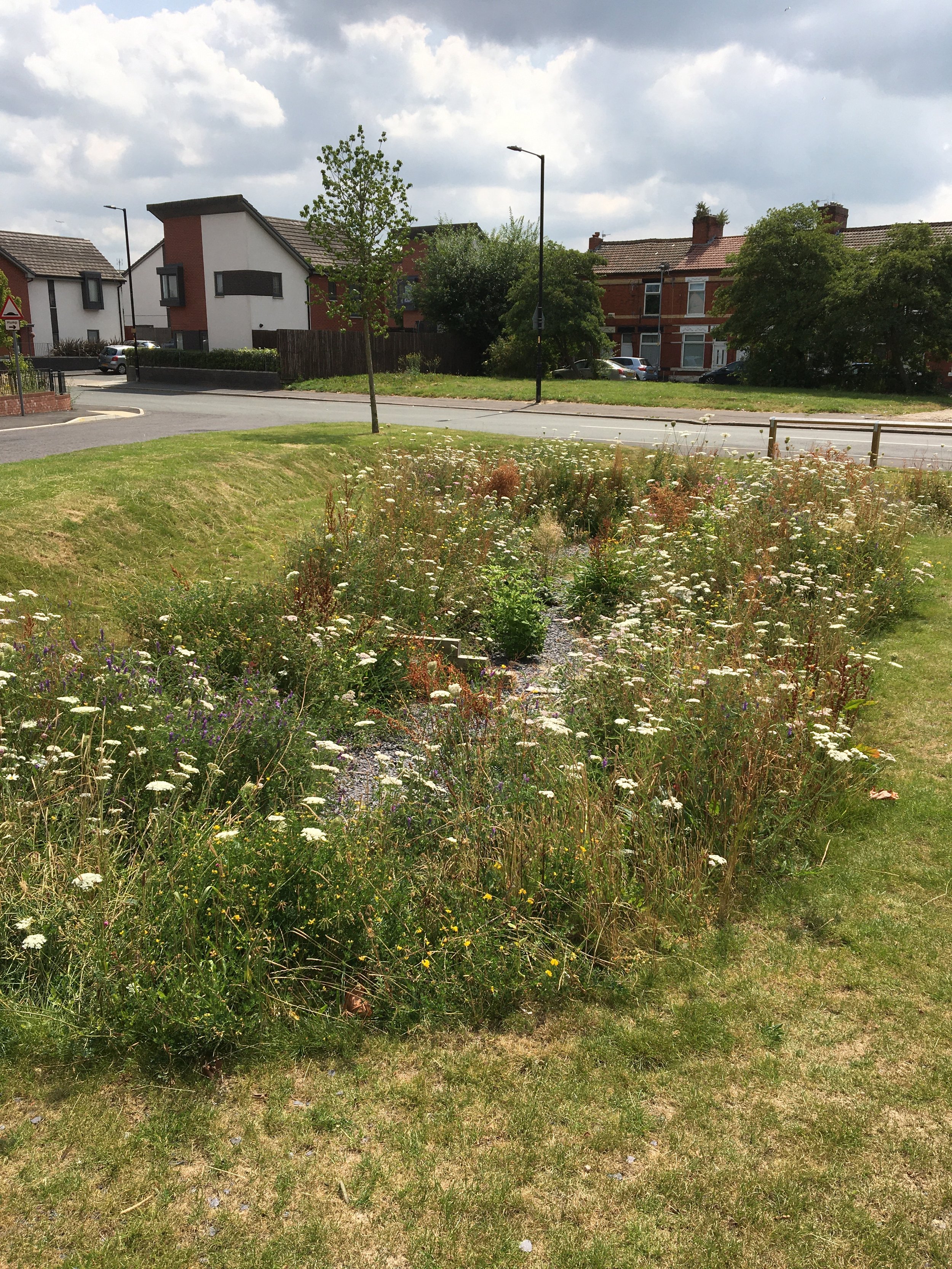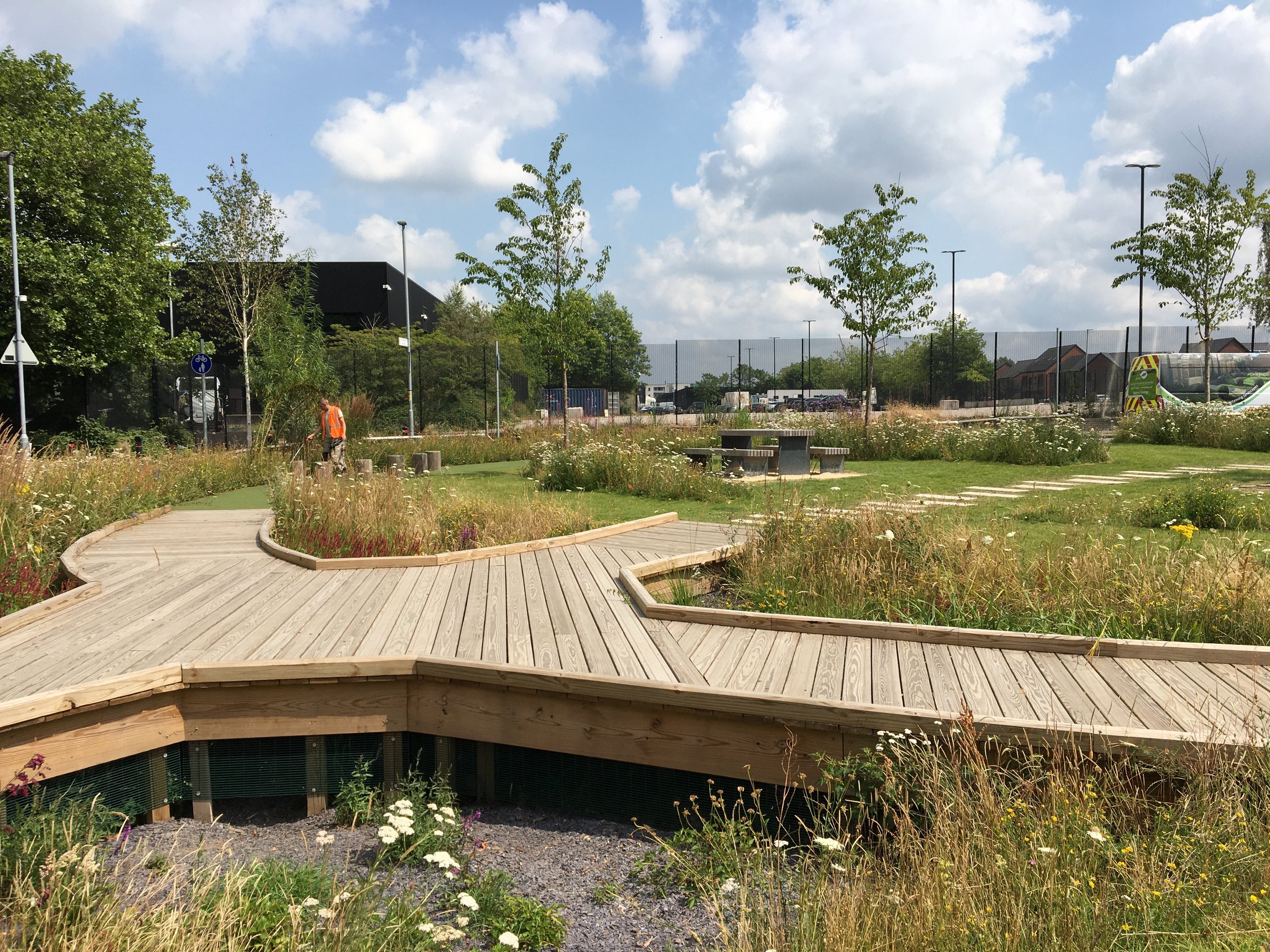Sustainable drainage systems (SuDS)
West Gorton Community Park (Photo - Paul O’Hare)
Sustainable drainage systems (or SuDS) can help us adapt to the impacts of climate change.
SuDS can not only reduce the risk of flooding from storms and heavy rainfall but brings benefits for biodiversity by creating vital local habitats.
When attenuating water, SuDS often use ‘soft engineered’ surface features rather than ‘hard-engineered’ underground storage using concrete or plastic tanks.
They are designed to manage rainwater and stormwater flows as locally as possible either through attenuation (storage), infiltration into the ground (replicating natural drainage) or a combination of these.
Some principles for good SuDS design
• A ‘management train’ – using a number of SuDS components in series and characterising areas into land use and drainage type.
• Source control – managing runoff as close as possible to where it falls as rain.
• Managing water on the surface – wherever possible, runoff should be managed on the surface.
• Early and effective engagement – consider the use of SuDS at the earliest stages of site selection and design.
Find ourt more: www.local.gov.uk/topics/severe-weather/flooding/sustainable-drainage-systems
Sustainable drainage systems and swales with landscaping and native planting at West Gorton Community Park, known locally as ‘sponge park’.
Image credit - Paul O’Hare
Backyard SuDS
Although most commonly used at street or neighbourhood scale, the principles of sustainable drainage systems can be applied at much more localised scales as ‘rain gardens’ or ‘backyard SuDS’. These are shallow landscaped depressions that reduce rainfall run off.
Like their larger counterparts, they too reduce the amount of water entering the drainage network by capturing and storing rainwater, allowing it to infiltrate into the ground, or releasing it into the drainage network in a slow, managed way. Rain garden performance can be enhanced by engineering the sub-base to include a layer of gravel that filters pollutants and sediments (sometimes referred to as bioretention systems).
For further information on rain gardens, see Designing Rain Gardens: A Practical Guide.
Challenges to sustainable drainage systems
Though an increasingly common feature across the built environment, SuDS face technical challenges and are not always popular. One of the main challenges to implementing SuDS is the expense of construction. Some require relatively extensive ground works, design and engineering. They may also remove land that would otherwise be developed, potentially making them an unappealing prospect for financiers and developers. SuDS can sometimes have only a very limited ability to treat water quality and require long-term maintenance that needs to be financed across a period of time.
Examples of local sustainable drainage systems
- The IGNITION Project – “a ground-breaking project that aims to develop innovative financing solutions for investment in Greater Manchester’s natural environment. This investment will help to build the city region’s ability to adapt to the increasingly extreme impacts of climate change.” The IGNITION project focuses particularly on SuDs and who the benefits effect and why they’re so powerful.
- Green drainage scheme – Funded by the Natural Course project the pioneering green drainage scheme in 2018 was set to “save millions if replicated across Manchester.” A team built a rain garden and transformed a large area of parking and pathways at Moorlands Junior School in Sale to demonstrate the benefits of sustainable drainage.
- The Urban Greening Company – Installed a unique water attenuation system (suds) on a residential apartment podium deck in Salford (working with IPS Group).
Further information & guidance
United Utilities guidance on SuDS: www.unitedutilities.com/builders-developers/wastewater-services/sustainable-drainage-systems/
Institute of Chartered Engineers SuDS Route Maps. https://www.ice.org.uk/engineering-resources/best-practice/sustainable-drainage-systems-suds-latest-guidance/
Susdrain (CIRIA) is a community that provides a range of resources for those involved in delivering sustainable drainage systems (SuDS). The website includes guidance on SuDS and case studies of successful SuDS schemes from across the country. www.susdrain.org
The SuDS Manual (C753), first published in 2007, provides the latest technical advice and adaptable processes to assist in the planning, design, construction, management and maintenance of good SuDS. The manual is available for free from the CIRIA website.
The Flood Hub SuDS toolkit https://thefloodhub.co.uk/sustainable-drainage-systems-suds-toolkit/
This Sustainable Drainage Systems (SuDS) Toolkit contains resources that introduces the concept of SuDS, and introduces the different places that can be integrated into places.
British Geological Survey research on SuDS: www.bgs.ac.uk/geology-projects/suds/



